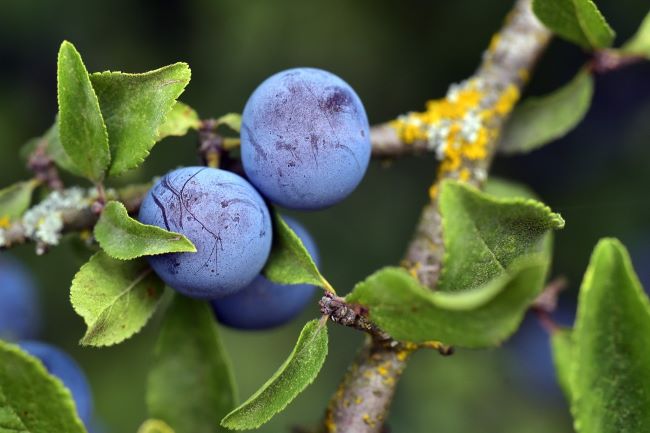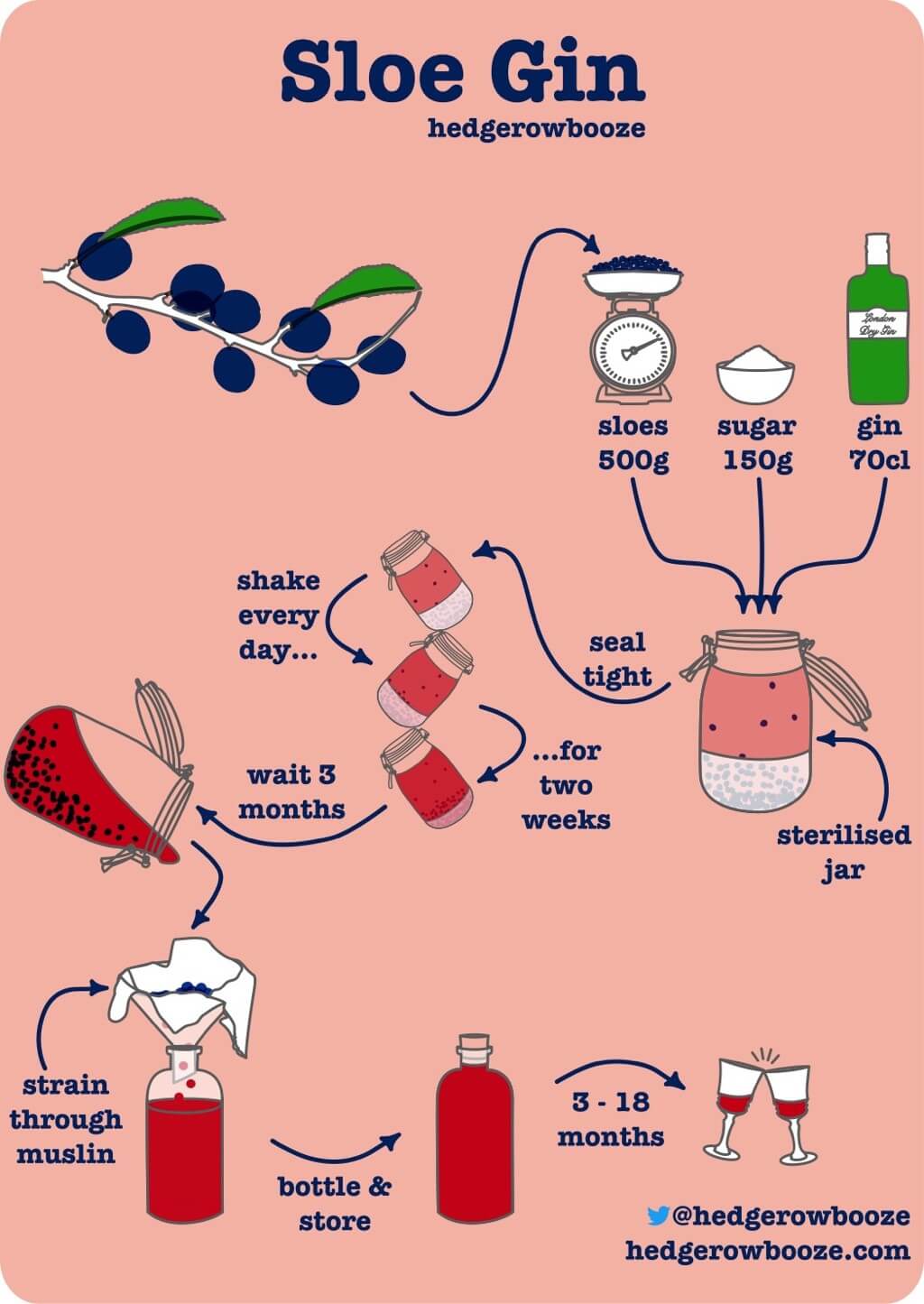Sloe Gin
This sweet and jammy winter liqueur is as easy to make as it is delicious!
Make in Late Autumn
Difficulty: Easy

Ingredients
Make this with any amount of sloe berries - just multiply or divide the amount of sugar and gin to keep everything in proportion
- 500g sloes
- 200g sugar (or 100g if you like it more tart - you can easily add more sugar later)
- 70cl bottle of gin
This works best with a neutral London dry gin, without too many botanicals which can clash with the sloe taste. You don't need to use a premium gin - the end result will improve whichever gin you choose - but go for something drinkable
Equipment
You will need
- Kilner jar, mason jar or similar
- Sieve
- Funnel
- Bottles
Remember to sterilise the kilner jar and bottles by boiling in a pan for 10 minutes before using them or you risk ending up with a sour tasting drink in the end

Method
The Sloes
Collect your sloes when they ripen in early autumn, if possible from a sunny spot where the berries will be sweeter. Ripe berries give a little when you squeeze them
As with all foraging, make sure you identify the blackthorn bush correctly. Sloes grow on woody, thorny, black-barked branches on small trees. Always forage responsibly to leave some sloes for our feathered friends
Traditionally, the sloes were picked after the first frosts to break down the skin and allow the flavour to infuse fully. Put the berries in the freezer overnight instead, or prick each one with a pin if you can't wait overnight
The Infusion
Sterilise the kilner jar, then add the berries, sugar and gin in that order
Shake to start to dissolve the sugar
Leave it for around 3 months, shaking every day for the first three weeks until the sugar is all dissolved, and then leave it in a cool dark place for the rest of the three months
After three months, strain it to remove the fruit and any sediment
Have a taste! This recipe uses a little less sugar than some others so add some sugar if it is too tart at this point (see below for more info)
Bottle your sloe gin and you're done. Ideally leave it for at least another three months to mature in the bottle, if you can resist it!
The Alternative
For a richer drink, use dark sugar instead of white sugar and leave the strained gin to mature in the bottle for 1-2 years. It can taste bitter when first bottled, but will mature over time so be patient and you will be richly rewarded!
Troubleshooting
It Isn't Sweet Enough
Just add sugar. Either add a small spoon of sugar at a time, shake to dissolve and taste, or make a syrup and stir/shake it in.
For the syrup: add 3 parts sugar to 2 parts water by volume to a pan and heat gently until the sugar is dissolved. Let it cool and then add to your sloe gin. Just add a little at a time - you can't take it back out again once it's in there
It's too sweet
There is no quick fix unfortunately. The only real cure is to make another batch of sloe gin with a lot less sugar and blend the two together. On the bright side, you will end up with double the sloe gin!
I Can't Wait For Sloe Season!
You're in luck - dried sloes work well with this recipe. See below for more details
Questions and Answers
How Do I Identify A Sloe Tree?
Sloes grow on a viciously thorned small tree or bush. Its leaves are 2-4cm (1-2inches) long and classically leaf shaped with a slightly jagged edge. The berries themselves are small 1cm (3/8 inch), blue-black, and very sour when eaten raw.
If in doubt, take a look in the library for a guide or read through the Woodland Trust's guide to the sloe tree. Don't confuse the sloe berry with the poisonous deadly nightshade (atropa belladonna) or black nightshade (solanum nigrum) berries - neither of these are tree fruit and they grow on floppy thornless branches but may wind through trees as they grow
Where Can I Find Sloes?
Sloe trees are often found in old hedgerows because their fearsome thorns are enough to stop most livestock. Sloes grow through most of the UK and Ireland, and the tree is native to Europe and the middle east. It is naturalised in parts of Australia and New Zealand, and introduced to the USA. So the odds are there are some sloes growing within your reach!
Can I Use Sloes Twice For My Sloe Gin?
Yes, at a pinch the sloes will keep enough flavour to make a second batch of gin, although they will have lost some flavour and will make a less intense liqueur. You will have to leave them in the jar for a lot longer: leave 5-6 months before bottling, and remove the stones before adding the fruit to the sugar and gin for this second batch or you may be left with an almond taste from the stones. Otherwise the recipe is the same as the recipe with fresh sloes above
What Can I Do With Sloes After Using Them For Sloe Gin?
If you don't want to waste the gin-soaked sloes after making sloe gin, then use them to make some gin-soaked sloe chocolates or sloe cider (also known as slider)
How Do I Make Gin-Soaked Sloe Chocolates?
To make gin-soaked sloe chocolates:
- Remove the stones from the sloes and slice them into small slices (or blitz them in a blender)
- Melt one bar of dark chocolate and one of milk chocolate in a bain marie and stir in the sliced sloes
- Pour into a tray and leave to set into a delicious sloe-gin bar of chocolate
- Alternatively pour into an ice cube tray to make little balls of sloe gin chocolate loveliness!
How Do I Make Sloe Cider (Slider)?
To make slider:
- Use a good quality dry cider (this is hard cider in the US)
- Put your gin-infused sloes into a demijohn and add twice as much cider by volume
- Fit the airlock or a balloon with a pinprick, leave it for 6-8 weeks and decant into bottles, leaving the sediment in the cider
Beware - this is a potent combination that packs a punch!
Can I Use Dried Sloes To Make Sloe Gin?
Yes, dried sloes will make a fine sloe gin. If you can't wait until autumn to make your sloe gin, or don't have access to fresh sloe berries, then you can order dried sloes online
To prepare the dried sloes, first wash and drain them well. Submerge in a pot of cold water, soak for a few minutes and discard the water to remove any bits or surface bloom. Repeat until the water runs clear. Then soak them in clean water overnight to rehydrate the berries, or if you are in a hurry you can heat very gently in a pan of water until they are plump. 300g dried sloes will give you around 500g rehydrated sloes. Use the soaked rehydrated sloes in place of the same weight of fresh sloes in the standard sloe gin recipe
If you started with 300g dried sloes then you will end up with about 500g after soaking them which means you should use the same amount of sugar and gin as in the recipe above. With more sloes then you will need more gin and more sugar - for example double the sloes then double the other ingredients and double the liqueur at the end
